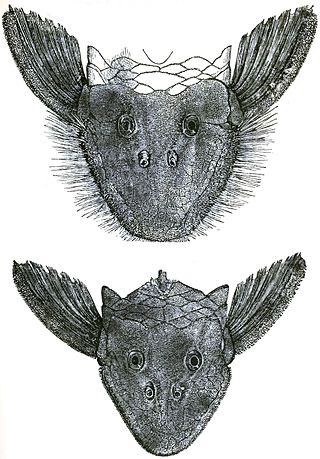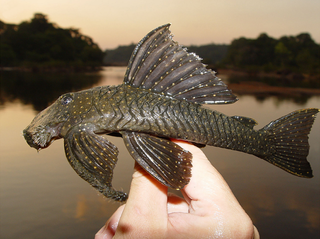
The Orinoco is one of the longest rivers in South America at 2,250 kilometres (1,400 mi). Its drainage basin, sometimes known as the Orinoquia, covers 989,000 km2 (382,000 sq mi), with 76.3 percent of it in Venezuela and the remainder in Colombia. It is the fourth largest river in the world by discharge volume of water. The Orinoco River and its tributaries are the major transportation system for eastern and interior Venezuela and the Llanos of Colombia. The environment and wildlife in the Orinoco's basin are extremely diverse.

The Hypostominae are a subfamily of catfishes of the family Loricariidae. Most members are restricted to tropical and subtropical South America, but there are also several species in southern Central America. Hypostomus plecostomus, which is popular in the aquarium trade, has been introduced to several regions far from its native range.
Dekeyseria is a genus of suckermouth armored catfishes native to tropical South America.

Pseudancistrus barbatus, commonly known as the bearded catfish, is a species of catfish in the family Loricariidae. It is native to South America, where it occurs in the basins of the Oyapock, the Mana River, the Maroni, the Suriname River, the Courantyne River, and the Essequibo River. Within its range, the bearded catfish is typically found in rocky, fast-flowing rapids.

Pseudancistrus zawadzkii is a species of catfish in the family Loricariidae. It is native to South America, where it occurs in the Tapajós basin, including the Tracuá River, in Brazil. It is typically found in areas with clear water, rocky outcrops, small waterfalls, and a substrate of rocks and sand. The species reaches 12.9 cm SL.

Pseudancistrus nigrescens is a species of catfish in the family Loricariidae. It is native to South America, where it occurs in the upper Potaro River basin in Guyana. The species reaches 18.2 cm in total length.
Pseudancistrus orinoco is a species of catfish in the family Loricariidae. It is native to South America, where it occurs in the Orinoco basin. The species reaches 10 cm in total length.
Pseudancistrus pectegenitor is a species of catfish in the family Loricariidae. It is native to South America, where it occurs in the main channel of the Orinoco near the mouth of the Ventuari River, as well as in the Casiquiare. The species is usually found in areas with flowing water near large rocky outcrops. It reaches 24.2 cm SL.
Spectracanthicus immaculatus is a species of catfish in the family Loricariidae. It is native to South America, where it occurs in the Tapajós basin in Brazil. The species reaches 8.2 cm SL. Its specific epithet, immaculatus, is derived from a Latin word translating to "spotless", referring to the species' lack of any form of spotted patterning.
Hypostomus rhantos is a species of catfish in the family Loricariidae. It is native to South America, where it occurs in the Ventuari River as well as the upper Orinoco, ranging from above Puerto Ayacucho to the Casiquiare in Venezuela. The species reaches 19.6 cm SL. Its specific epithet, rhantos, derives from a Greek word meaning "speckled" and refers to the species' pattern of small spots.
Hypostomus kuarup is a species of catfish in the family Loricariidae. It is native to South America, where it occurs in the Culuene River in the Xingu River basin in the state of Mato Grosso in Brazil. It is typically found in rapids within its range, although the type locality of the species has subsequently dried out due to the construction of a nearby dam. Despite this, it is still known to inhabit rapids above and below the dammed area, as well as a fish ladder built near the type locality. It is sympatric with its congener Hypostomus faveolus.
Hypostomus macushi is a species of catfish in the family Loricariidae. It is native to South America, where it occurs in the Essequibo River, the Ireng River, the Rupununi, and the Takutu River along the border of Brazil and Guyana. It is typically seen near dead, submerged wood in areas with moderate to fast-flowing water. The species reaches 17 cm SL and is believed to be a facultative air-breather. Its specific epithet, macushi, refers to the Macushi people of the Rupununi region who collected specimens of the species and are stated to have provided the authors of its description, Jonathan W. Armbruster and Lesley S. de Souza, with hospitality while in Guyana.
Hypostomus soniae is a species of catfish in the family Loricariidae. It is native to South America, where it occurs in the Tapajós basin in the state of Pará in Brazil. The species reaches 16.4 cm in standard length. Its specific epithet, soniae, honors Sonia Fisch-Muller, a curator at the Museum of Geneva specializing in loricariid systematics who collected the type material.
Hypostomus weberi is a species of catfish in the family Loricariidae. It is native to South America, where it occurs in the middle Rio Negro in Brazil. One record of the species' occurrence refers to a "río Cicipa", which is thought to possibly correspond with the Siapa River, a tributary of the Casiquiare in Venezuela. The species is typically found in rapids or flooded forest environments. It reaches 17.5 cm SL and is known to feed on detritus. Its specific epithet, weberi, honors Claude Weber of the Natural History Museum of Geneva, for his contributions to knowledge of the genus Hypostomus.
Hypostomus carinatus is a species of catfish in the family Loricariidae. It is native to South America, where it occurs in the middle Amazon River basin. The species reaches 24.8 cm SL and is believed to be a facultative air-breather.
Hypostomus faveolus is a species of catfish in the family Loricariidae. It is native to South America, where it occurs in the basins of the Tocantins River and the Xingu River in central Brazil. Adults of the species are typically found in both rapids and slow-flowing sections of medium to large rivers with varying substrates, although juveniles have been found in oxbow lakes and smaller streams. The species reaches 20.6 cm in standard length and is believed to be a facultative air-breather. Its specific epithet, faveolus, is derived from a Latin word meaning "honeycomb", referencing the honeycomb-like patterning exhibited by the species.
Hypostomus gymnorhynchus is a species of catfish in the family Loricariidae. It is native to South America, where it occurs in coastal drainages of French Guiana, ranging from the Oyapock to the Maroni basin. It is a rheophilic species that occurs in shallow, sunny rapids with strong currents and rocky substrates. While the species can reach 26.6 cm in standard length, it rarely exceeds 20 cm.
Ancistomus feldbergae is a species of catfish in the family Loricariidae. It is native to South America, where it occurs in the Xingu River basin in Brazil.

Guyanancistrus brevispinis is a species of catfish in the family Loricariidae. It is a freshwater fish native to South America, where it occurs in the Atlantic coastal drainages of the Guianas, ranging from the Nickerie River basin to the Oyapock basin in French Guiana and Suriname. It has also been reported from Guyana, but this is believed to be a misidentification. The species is considered the most common and abundant member of the genus Guyanancistrus, occurring in rocky streams with flowing water, especially in the vicinity of plunging waters. It is known to coexist with members of the genus Lithoxus in small forested creeks as well as rapids. The species reaches 14.2 cm in standard length.

Guyanancistrus niger is a species of catfish in the family Loricariidae that is of disputed classification. It is native to South America, where it occurs in the Oyapock basin in French Guiana. Though reportedly uncommon, it is typically seen in rapids where the species Pseudancistrus barbatus is also present, although the ecological relationship between the two is not known. The species reaches 15.9 cm in standard length, although it has been reported to reach 25.4 cm, and it may be a facultative air-breather.





